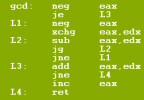History of Intel CPUs*
| 1978 |
8086 |
16-bit processor, up to 1MB RAM, available in
5,6,8 and 10 MHz, 29K transistors. |
| 1979 |
8088 |
chosen for the first IBM PC. |
| 1982 |
80286 |
up to 16MB RAM, up to 20 MHz, 134K transistors,
virtual memory and protected mode. |
| 1985 |
80386 |
32-bit processor, up to 4GB RAM,
up to 33 MHz, 275K transistors,
instruction pipelining. |
| 1989 |
80486 |
1.2M transistors,
integrated FPU, 8KB on-chip cache. |
| 1993 |
Pentium |
up to 200MHz, two 8K caches. |
| 1995 |
Pentium Pro |
RISC chip, more stages in pipeline,
on-board L2 cache. |
| 1997 |
Pentium II |
MMX instruction, dynamic execution,
up to 450MHz. |
| 1999 |
Pentium III |
SSE instruction, up to 1+GHz. |
| 2000 |
Pentium IV |
Hyper pipeline, Rapid execution engine,
Execution trace cache, 3.8+GHz. |
| 2005 |
Pentium D |
Dual core. |
|
Course overview
This course is about computer organization and assembly languages.
You might wonder why learning assembly languages. After all, who will
write assembly programs these days.
Actually, people still write assembly for faster codes (compiler
is not as smart as men yet), smaller codes (for devices with limited
amount of memory such as mobile devices) and specific architectures
(in which there are not even compilers, for example, early GPUs).
With these in mind, other than the fundamentals about assembly
programming, this course emphasizes on code optimization techniques
on writing fast and small codes. This course is divided into three parts:
- TOY. we will
teach a virtual machine called TOY, developed by Princeton. This is
a machine with ancient designs. However, modern computers evolve
from such simple designs and share the same princeples with TOY.
By learning TOY, you will understand why computers work in the way
they work. In addition, you will have you first bite of assembly
programming using our own home-brewed TOY assembler and emulator.
- ARM. ARM processors is a widely used processor for its
power saving capability. It has been used in Gameboy Advance, iPod,
mobile phones, iPhone and many other devices. It is a RISC machine
as its name suggests. Thus, its instruction set is of a moderate size
and its architecture is simple. You will develop your first real assembly
program for ARMs. In addition, we will teach architecture and programming
for Gameboy Advance (GBA). GBA is a good platform to learn low-level
programming as your program has to control everythings itself. In addition,
there is nothing with more fun than seeing your programming running on
such a lovely console.
- Intel. For the third part, we will move to Intel x86 assembly
programming. Such processors are widely available on your desktop. In addition
to the fundamental programming for x86, we will also cover advanced
topics such as float-point programming and SIMD programming.
Meeting time:
2:20am-5:20pm every Monday
Classroom:
CSIE Room 102
Instructor:
Yung-Yu Chuang
Teaching assistants:
Ken-Yi Li
 ,
Chang-yen Hsieh ,
Chang-yen Hsieh

TA Office hours:
13:30-15:30 Wednesday Room 106
14:00-16:00 Thursday Room 106
Mailing list:
Subscribe  via
this website. via
this website.
Textbook:
References:
Grading:
- 4 assignments (50%)
- class participation (5%)
- midterm exam (15%)
- final project (30%)
Syllabus (topics we might cover):
- Combinational circuits
- Sequential circuits
- TOY architecture
- TOY programming
- Assembly language fundamentals
- ARM architecture
- ARM programming
- Gameboy advance architecture
- Gameboy advance programming
- IA-32 Processor Architecture
- Data Transfers, Addressing,and Arithmetic
- Procedures
- Conditional Processing
- Integer Arithmetic
- Strings and Arrays
- Structures and Macros
- High-Level Language Interface
- SIMD
- Real Arithmetic
- Code Optimization
|

 ,
Chang-yen Hsieh
,
Chang-yen Hsieh

 via
this website.
via
this website.





